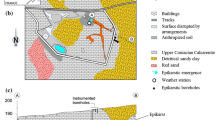Abstract
We monitored 222Rn (half life: 3.82 d) and 220Rn (half life: 56 s) activities every hour in a limestone cave, Seongryu Cave, Korea, from May to July 2010. The activities of both nuclides in this cave were highest at night and lowest during the day owing to active ventilation with outside air during the day. As the outside air temperature increased from May to July, 222Rn activity increased by 2–3 times. A simple mixing model of hourly 222Rn variation revealed that the ventilation with outside air decreased by a factor of 3–4 from May to July. The daily average of 222Rn activities correlated well with the daily average temperature of the outside air, indicating that the ventilation with outside air is controlled mainly by outside-air density, rather than by the diurnal amplitude of the outside air temperature. Although the trend of the diurnal variation of 220Rn was similar to that of 222Rn, its increase from May to July was only 65%. Since the short-lived 220Rn does not have any stacking effect over different days and the diffusive flux is negligible, 220Rn activities indicated increases in the advective pore-air input rates of cave rocks from May to July, which are consistent with the modeling result of hourly 222Rn variations. Thus, our study suggests that the dual Rn tracers provide key information on the micro- and macro air-ventilation processes of caves.
Similar content being viewed by others
References
Burnett, W.C., Kim, G., and Lane-Smith, D., 2001, A continuous monitoring for assessment of 222Rn in the coastal ocean. Journal of Radioanalytical and Nuclear Chemistry, 249, 167–172.
de Freitas, C.R., Littlejohn, R.N., Clarkson, T.S., and Kristament, I.S., 1982, Cave climate: Assessment of airflow and ventilation. International Journal of Climatology, 2, 383–397.
Dueñas, C., Fernandez, M.C., Cañete, S., Carretero, J., and Liger, E., 1999, 222Rn concentrations, natural flow rate and the radiation exposure levels in the Nerja Cave. Atmospheric Environment, 33, 501–510.
Gillmore, G.K., Sperrin, M., Philips, P., and Denman, A., 2000, Radon hazards, geology, and exposure of cave users: a case study and some theoretical perspectives. Ecotoxicolog y and Environmental Safety, 46, 279–288.
Gillmore, G.K., Philips, P., Denman, A., Sperrin, M., and Pearce, G., 2001, Radon levels in abandoned metalliferous mines, Devon, Southwest England. Ecotoxicology and Environmental Safety, 49, 281–292.
Gillmore, G.K., Philips, P., Denman, A., and Gilbertson, D., 2002, Radon in the Creswell Crags Permian limestone caves. Journal of Environmental Radioactivity, 65, 165–179.
Kim, L., Woo, K.S., Kim, B.H., Park, J.S., Park, H.Y., Jeong, H.J., and Lee, J.H., 2010, Scientific significances of the Seongryu Cave (Natural Monument No. 155). Annual review in cultural heritage studies, 43, 236–259.
Kowalczk, A.J. and Frielich, P.N., 2010, Cave air ventilation and CO2 outgassing by radon-222 modeling: How fast do caves breathe? Earth and Planetary Science Letters, 289, 209–219.
Lario, J., Sánchez-Moral, S., Cañaveras, J.C., Cuezva, S., and Soler, V., 2005, Radon continuous monitoring in Altamira Cave (Northern Spain) to assess user’s annual effective dose. Journal of Environmental Radioactivity, 80, 161–174.
Lario, J., Sánchez-Moral, S., Cuezva, S., Taborda, M., and Soler, V., 2006, High 222Rn levels in a show cave (Castañar de Idor, Spain): Proposal and application of management measures to minimize the effects on guides and visitors. Atmospheric Environment, 40, 7395–7400.
Perrier, F., Richon, P., Crouzeix, C., Morat, P., and Le Mouel, J.-L., 2004, Radon-222 signatures of natural ventilation regimes in an underground quarry. Journal of Environmental Radioactivity, 71, 17–32.
Perrier, F., Richon, P., Cautam, U., Tiwari, D.R., Shrestha, P., and Sapkota, S.N., 2007, Seasonal variations of natural ventilation and radon-222 exhalation in a slightly rising dead-end tunnel. Journal of Environmental Radioactivity, 97, 220–235.
Przylibski, T.A., 1999, Radon concentration changes in the air of two caves in Poland. Journal of Environmental Radioactivity, 45, 81–94.
Sesana, L., Caprioli, E., and Marcazzan, G.M., 2003, Long period study of outdoor radon concentration in Milan and correlation between its temporal variations and dispersion properties of atmosphere. Journal of Environmental Radioactivity, 65, 147–160.
Tanahara, A., Taira, H., and Takemura, M., 1997, Radon distribution and the ventilation of a cave on Okinawa. Geochemical Journal, 31, 49–56.
Whittlestone, S., James, J., and Barnes, C., 2003, The relationship between local climate and radon concentrations in the Temple of Baal, Jenolan Caves, Australia. Helictite, 38, 39–44.
Wilkening, M.H. and Watkins, D.E., 1976, 222Rn concentrations in the Carlsbad caverns. Health Physics, 70, 139–145.
Author information
Authors and Affiliations
Corresponding author
Rights and permissions
About this article
Cite this article
Oh, Y.H., Kim, G. Factors controlling the air ventilation of a limestone cave revealed by 222Rn and 220Rn tracers. Geosci J 15, 115–119 (2011). https://doi.org/10.1007/s12303-011-0010-3
Received:
Accepted:
Published:
Issue Date:
DOI: https://doi.org/10.1007/s12303-011-0010-3




